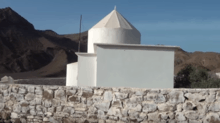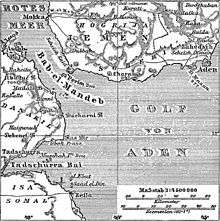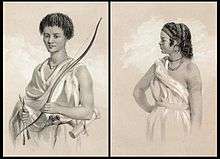Issa (clan)
|
| |
 The Tomb of Sheikh Issa | |
| Regions with significant populations | |
|---|---|
| Languages | |
| Somali | |
| Religion | |
| Islam | |
| Related ethnic groups | |
| Gadabuursi, other Dir groups and Somali clans |
The Issa or Eesah or Aysa (Somali: Ciise, Reer Sheikh Ciise, Arabic: عيسى) are a northern Somali clan, a sub-division of the Dir clan family.[1]
Members primarily reside in Djibouti, Awdal in Somalia, as well as the Shinile Zone located in the Somali Region of Ethiopia and is one of the largest clans of the Dir. Traditionally, they live as nomadic cattle breeders, but they also engage in trade and have contacts throughout the region. The populations of Six major cities of Djibouti: Djibouti City, Ali Sabieh, Arta, Dikhil, Holhol, Ali Adde and Assamo – are predominantly Issa and in Ethiopia: Dire Dawa, Ayesha, Adigale, Erer and Āfdem and Somalia: Zeila, Xariirad, Jidhi and Lughaya As a sub-clan of the Dir, the Issa clan traces their paternal ancestry to Irir, one of the sons of Samaale.
History
The Issas live in the same regions that the Gurgure Madaxweyn Dir of Ethiopia Dirre Dhabe area. The name of this location means were the "Dir Hit" Meeshii Dir Dhabah in reference to 14th century battles between the Sultanate of Ifat and Gallas.
Since the colonial period, in the construction of the railway line from Addis Ababa to Djibouti City at the beginning of the 20th century, the French builders used mainly the Issa as bearers, workers and guards. In the Italian invasion of Ethiopia in 1935/36, Issa fought on the Italian side, in return benefited from weapons and military training and lucrative marketing opportunities for their cattle. In the second half of the twentieth century, Somalia supplied additional weapons to the Issa, which it upgraded as part of the West Somalia Liberation Front. All this contributed to the fact that the Issa repressed the Afar from the area of today's Shinile zone. Somali-Ethiopian war in 1963, a terrible massacre was perpetrated by the Ethiopian soldiers in Aysha, mainly populated by the Issa Somali. Among the latter, those who succeeded in fleeing arrived at Dikhil and Ali Sabieh in Djibouti. The drought and hunger crisis of 1972-1973/74 intensified the conflicts. The Ethiopian army intervened against the Issa and in 1971/72 killed hundreds and seized nearly 200,000 cattle.
After the defeat of the Western Somali Liberation Front, the Issa Division remained under the name Issa and Gurgura Liberation Front . She continued to receive support from Somalia and joined the EPRDF. In 1987, the Autonomous Region of Dire Dawa was created for the Issa (which had previously belonged to the province of Xararge) as part of a new administrative division of Ethiopia. Since the EPRDF took over in 1991, the Issa areas in Ethiopia are part of the ethnic definition Somali region.[2]
In Djibouti, which was colonized by France under the name of the French Coast of Somalis, (up until 1967, then to the French Territory of the Afars and the Issas), there were also tensions between Issa and Afar, as the Issa sought to connect with Somalia independent since 1960. Most Afar preferred the fate of France. Mahamoud Harbi was a major leader of the independence movement. In 1977 the Issa established the independence of Djibouti, but not the union with Somalia. Under Hassan Gouled Aptidon, Djibouti developed into the one-party state of the Rassemblement Populaire pour le Progrès (RPP) In which the interests of the Afar minority were little considered. 1991-1994, there was therefore a civil war in Djibouti between the Issa-dominated government and the Afar rebels of the FRUD. Finally, other opposition parties were admitted and Afar was involved in the government, while Issa still dominated political life. In 1999, Ismail Omar Guelleh, a nephew of Hassan Gouled Aptidon, succeeded Djibouti as his successor. The Issa still dominate political life. In 1999, Ismail Omar Guelleh, a nephew of Hassan Gouled Aptidon, succeeded Djibouti as his successor.

In the Awdal region of Somalia there were battles with the Gadabuursi, another Dir subclan. The conflict drove some of the Issa to escape to Ethiopia in the late 1980s. A refugee camp was opened at Degago/Ayisha. A second wave of Issa refugees left the coastal town of Zeila in 1991 after fighting with the SNM of the Isaaq clan.[3] The Issa organization United Somali Front had previously tried to connect Zeila to Djibouti. In the same year, the north-west of Somalia, including Awdal under the leadership of the SNM as Somaliland, a country which has as of 2017 not been recognized by any country. In the lower house of the Somaliland Parliament (House of Representatives), six out of 82 were members of Issa in 2005. Since the 2005 elections, only one Issa (as a member of the government division UDUB ) has been represented. This decline is mainly explained by the fact that the Issa in Awdal instead of to Somaliland are increasingly oriented towards the neighboring Djibouti.
Distribution
The Issa primarily live in Ethiopia largely where they reach the Oromia and Afar regions and make a large chunk of the Chartered city of Dire Dawa. They also inhabit Djibouti, were they make up half of the population, thirdly they inhabit northwestern Somalia too.[4] The Issa are the largest clan by population within the Djibouti. Also the Issa is the second largest sub-clan within the borders of the Somali region of Ethiopia based on the Ethiopian population census 2008.
The immediate neighbor to the Issa to the west are the Afar (or Danakil) with whom the Issa used to frequently fight. I. M. Lewis used to refer to it as "a of an almost constant state of enmity between the 'Ise and the 'Afar" , To their east the 'Ise are in contact with the Somali Gadabursi to whom they feel themselves akin and share same descent and culture. To the South the Gurgura, Hawiye and Oromo.[5]:70[6]
As Dir sub-clan, the Issa have immediate lineal ties with the Gurgura, the Surre (Abdalle and Qubeys), the Gadabursi, the Biimaal (who the Gaadsen also belong too), the isaaq, the Bajimal, the Bursuk, the Madigan, the Garre (the Quranyow sub-clan to be precise as they claim descent from Dir), Gurre, Gariire , other Dir sub-clans and many different Samaale clans.[7][8][9][10]
Lineage
The Issa traditionally traces its Arabian connexions through its Dir affiliations to Aqeel ibn Abi Talib. However, by 1962 it had become the practice to regard the clan founder as a sheikh or even saint in much the same way (and no doubt at least partly in response to their claims) as the eponyms of the Darod and Isaaq clans. Although I.M. Lewis knows of no printed hagiologies in honor of the Issa ancestor, by the time of Lewis's writing a number of hymns (or qasiidas) have been composed for him, and there is a shrine in Djibouti City where he is said to have appeared miraculously. His actual grave lies between Rugay and Maydh in northeastern Somalia.[11] Sheikh Issa tomb most likely pre-date the local arrival of Islam, which would mean their construction took place in the 13th century or earlier.
The traditional Ugaas comes from the smallest Issa clan, Wardiiq and rules from his settlement Waruf located 180 Km south of Djibouti, west of the Harrar road. One of their Ugaas's was Ugaas Hassan Xirsi Ugaas.
Clan tree

There is no clear agreement on the clan and sub-clan structures and many lineages are omitted. The following listing is taken from the World Bank's Conflict in Somalia: Drivers and Dynamics from 2005 and the United Kingdom's Home Office publication, Somalia Assessment 2001.[12][13]
- Dir
- Akisho (Akisho)
- Gadabuursi (Gadabursi)
- Bimal (Biimaal)
- Issa
Based on the Notes on the social organisation of the 'Ise Somal. The Isse is divided into the following branches.[5]:73
- Issa
- Ēlēye' (Musse & Mamasan)
- Hōlle (Fūrlabe)
- Hawlagadee(Walāldōn)
- Hōrrōne
- Ūrweyne
- Wardīq
In the south central part of Somalia the World Bank shows the following clan tree:[14]
Notable Issa people
- Mahmoud Harbi, Vice-President of the Government Council of French Somaliland.
- Hassan Gouled Aptidon 1916-2006, first President of Djibouti from 1977 to 1999.
- Ismaïl Omar Guelleh, President of Djibouti as of 1999
- Abdo Xamar Qoodh, musician
- Daher Ahmed Farah, Djiboutian politician
- Abdourahman Waberi, novelist
- Nima Djama, musician
- Ahmed Boulaleh Barreh, Djiboutian politician
- Mumin Gala, Djiboutian athlete
- Omar Farah Iltireh, Djiboutian politician
- Aden Robleh Awaleh, president of the National Democratic Party.
- Mohamed Ali Fourchette, musician
- Roble Olhaye, permanent representative to the United Nations for the Republic of Djibouti.
- Yacin Elmi Bouh, Djiboutian politician.
- Hussein Ahmed Salah, Djiboutian marathon runner.
- Moumin Bahdon Farah, Djiboutian politician.
Notes
- ↑ King, Preston (1987). An African Winter. Puffin. ISBN 0-14-052365-0. , p.169.
- ↑ Tobias Hagmann: Challenges of decentralisation in Ethiopia's Somali Region, Briefing for Review of African Political Economy Vol. 32, No. 103, 2005 (PDF)
- ↑ Guido Ambroso: Pastoral society and transnational refugees: population movements in Somaliland and eastern Ethiopia 1988–2000. New Issues in Refugee Research, Working Paper No. 65, UNHCR – Evaluation and Policy Analysis Unit, 2002 (PDF; 492 kB)
- ↑ Olson, James S. (1996). THE PEOPLE OF AFRICA: An Ethnohistorical Dictionary. London: GREENWOOD PRESS. p. 244. ISBN 0-313-27918-7.
- 1 2 Lewis, I.M. (1961). "Notes on the Social Organisation of the ʿĪse Somali". Rassegna di Studi Etiopici. Istituto per l'Oriente C. A. Nallino. 17: 69–82. JSTOR 41299496.
- ↑ Tesfaye, Aaron (2002). Political Power and Ethnic Federalism: The Struggle for Democracy in Ethiopia. Lanham, Maryland: University Press of America Inc. p. 135. ISBN 0-7618-2238-0.
- ↑ Hayward, R. J.; Lewis, I. M. (2005-08-17). Voice and Power. Routledge. p. 242. ISBN 9781135751753.
- ↑ The Quranyo section of the Garre claim descent from Dirr, who are born of the Irrir Samal. UNDP Paper in Keyna http://www.undp.org/content/dam/kenya/docs/Amani%20Papers/AP_Volume1_n2_May2010.pdf
- ↑ Adam, Hussein Mohamed; Ford, Richard (1997-01-01). Mending rips in the sky: options for Somali communities in the 21st century. Red Sea Press. p. 127. ISBN 9781569020739.
- ↑ Ahmed, Ali Jimale (1995-01-01). The Invention of Somalia. The Red Sea Press. p. 121. ISBN 9780932415998.
- ↑ Lewis, "Historical Aspects of Genealogies in Northern Somali Social Structure", Journal of African History, 3 (1962), p. 46
- ↑ Worldbank, Conflict in Somalia: Drivers and Dynamics, January 2005, Appendix 2, Lineage Charts, p.55 Figure A-1
- ↑ Country Information and Policy Unit, Home Office, Great Britain, Somalia Assessment 2001, Annex B: Somali Clan Structure Archived 2011-07-16 at the Wayback Machine., p. 43
- ↑ Worldbank, Conflict in Somalia: Drivers and Dynamics, January 2005, Appendix 2, Lineage Charts, p.56 Figure A-2
References
- King, Preston (1987). An African Winter. Puffin. ISBN 0-14-052365-0.